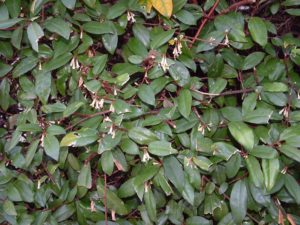 Elaeagnus x reflexa
Elaeagnus x reflexa
Just want to know how to kill it?
Skip to control methods
Also known as
Elaeagnus hybrid, Elaeagnus pungens, Elaeagnus glabra, Elaeagnus ‘variegata’
What does it look like?
Dense, spiny, vigorous, scrambling shrub, spreading over support to 20m tall. Stems are red-brown and long, arching and tough. Older stems have sharp spines. Introduced originally as a hedge species. Oval leaves green above & silvery or scaly brown on undersides. Hanging clusters of small, white fragrant flowers (Mar-May), followed by reddish-orange, drupe-like fruit (18 x 10 mm). Very tough, suckering rootstock.
Why is it a problem?
Extreme longevity, scrambling, spreading growth form and suckering roots, means it can form dense stands that slowly smother all other plants to canopy height. It can alter soil nutrient status by nitrogen fixing, affecting which native plant species can grow there.
Not grazed. Tolerant of drought, wet, high to medium-low temperature, wind, salt, most soil types, and moderate shade.
It prefers higher light levels and invades all types of shrublands, open areas within forest, roadsides, and rank areas. It is also able to invade even relatively shady sites, where, because it is extremely long-lived, it can await a light gap.
How does it spread?
Birds, and possibly possums and goats, spread the seed. Seed, while uncommon further south, is produced prolifically in Northland. Layering stems and suckers are spread in dumped vegetation. Common sources are old homestead and farm sites, roadsides, hedges, and tips.
How much of it do we have on the Whangarei Heads Peninsula?
The epicenter of the infestation is in Mcleod Bay, where it was originally introduced by early farmers for hedging purposes. There are extensive areas located here, but because of its relatively slow spread, while there are numerous individuals and locations, beyond the McLeod Bay area it is not yet at the same density as in Mcleod Bay
What can we DO about it at Whangarei Heads?
Elaeagnus, while seemingly slow to spread, once established becomes the dominant vegetation and is extremely hard to kill. Killing while it is still small, or even while it is an individual large shrub rather than a dense inaccessible thicket is key. Our aim is to support all landowners to undertake control of eleagnus to push it back toward McLeod Bay, and to then tackle the core of the infestation to protect Mt Manaia and Mt Aubrey, the northern faces of which are being significantly degraded by elaeagnus. Roadside control is being undertaken by WDC/NRC, focusing initially on the section from Ocean Beach to Taurikura.
Check out the control methods below:
How do I control it?
Special disposal notes: Cut stems can layer and resprout where in contact with the soil. Hang up off the ground to dry out, pile up to dry out and burn.
Additional safety note: Wear gloves and eye protection when working with Elaeagnus as its spines can cause injury.
- Cut stump application: Cut within 2 cm of ground level and immediately treat stump with Weed Action’s Gly/ Met Mix or picloram gel.
- Drill & Fill: Drill using 12-13mm auger bit sloping holes into the sapwood at 7-8 cm intervals around the base of the trunk and any exposed roots. & immediately fill each hole with Weed Action’s Gly/ Met Mix.
- Spray seedlings with triclopyr at 6mls/L of water + penetrant, best in spring and autumn
Extremely hard to kill. Repeat treatments needed.
CAUTION: when using any herbicide or pesticide PLEASE READ THE LABEL THOROUGHLY to ensure that all instructions and safety requirements are followed.
Click here for more information on the herbicides referenced in the control methods, or here for more information on the suggested techniques.
Photos of elaeagnus
